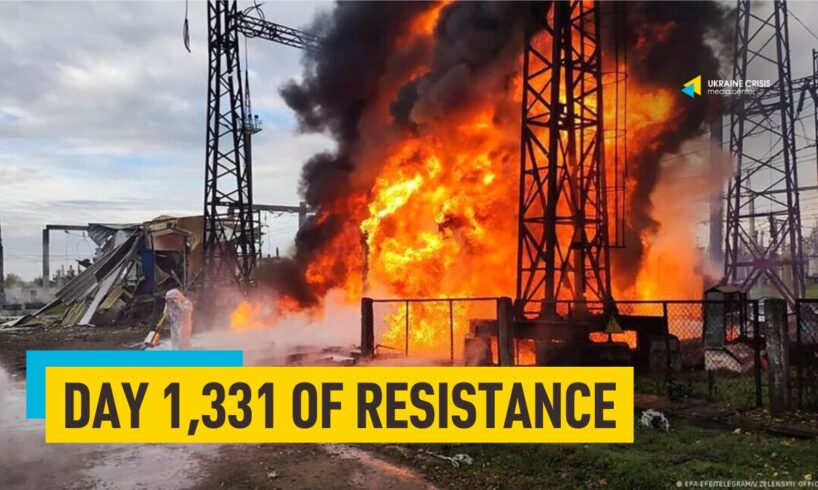
Russia launches 320 drones, 37 missiles at Ukraine overnight, targeting critical infrastructure. Russia’s war on Ukraine’s energy system enters a new phase. Nineteen countries pledge new aid to Ukraine at the 31st Ukraine Defense Contact Group meeting, Rutte says.
Russia launches 320 drones, 37 missiles at Ukraine overnight, targeting critical infrastructure
Russia launched 320 drones and 37 missiles at Ukraine overnight into Thursday, Ukraine’s Air Force said. The projectiles included 26 Iskander-M/KN-23 ground-launched ballistic missiles and two Kh-47M2 Kinzhal air-launched ballistic missiles.
Russian aerial attacks damaged critical infrastructure sites in the regions of Vinnytsya, Sumy and Poltava, Ukrainian President Volodymyr Zelenskyi said in a post to X on Thursday morning. A post office was ravaged in the city of Nizhyn in Chernihiv region, and one person was injured. In Kharkiv region, a critical infrastructure facility and a fire and rescue station were targeted, causing injuries, he said.
Ukraine’s private company DTEK Naftogaz halted gas extraction in Poltava region due to damage from a barrage of Russian drones and missiles overnight on Thursday, the company said in a post to Telegram.
Russia is using the double tap tactics to maximize casualties, Zelenskyi said. “There is confirmation that the Russians are using double terror: they strike targets with the Shaheds with cluster munitions and then repeatedly attack the sites to injure firefighters and energy teams working to restore the damage,” he explained.
“This autumn, the Russians use every single day to strike at our energy infrastructure. Putin has turned a deaf ear to everything the world says, so the only language that can still get through to him is the language of pressure – pressure through sanctions and pressure through long-range capabilities,” Zelenskyi said, adding “That is exactly what I will be discussing today and tomorrow in Washington.”
Zelenskyi will meet U.S. President Donald Trump in Washington on Friday. According to Axios, the two will discuss what weapons should be supplied to Ukraine, specifically if the U.S. should provide game-changing long-range Tomahawk missiles to the war-torn country. The U.S. could only send 20 to 50 Tomahawk missiles to Ukraine, an expert told the Financial Times. “They want to go offensive,” Trump told reporters on Wednesday.
Russia’s war on Ukraine’s energy system enters new phase
The upcoming heating season may well become more complicated and problematic than the winter of 2022-2023 when Ukraine experienced dozens of major attacks [on its energy grid], a widespread blackout and simultaneous power cuts to more than 10 million consumers, Ukrainian news outlet Ukrainska Pravda said in an editorial released on Thursday. We’ve translated excerpts from the article originally published in Ukrainian.
Unnamed sources in the energy sector told Ukrainska Pravda that judging by the tactics of the latest strikes and a scale of destruction they inflict it is clear that this time, Russia is determined to act even more cynically.
In 2022-2023, Russia relied on carpet bombings, using a large number of missiles and drones to attack various sites in different parts of the country. Its current tactics aims to “gradually bite off [the chunks]”, or knock down Ukraine’s energy system region by region.
First came the attacks on frontline regions and ones that share the border with Russia. These are the regions of Sumy and Chernihiv that are being pummeled most heavily. The attacks on the regions of Kharkiv, Odesa, Mykolayiv and Dnipro are also regular, but less intense.
Russia is trying to methodically destroy every part of Ukraine’s energy system by taking out local power generation, disrupting transmission that runs to large substations of Ukrenergo [national energy operator] and distribution in large cities through substations operated by regional energy companies.
In August and September, Russia mostly used drones to attack the sites, directing swarms of ten to forty drones at a single energy site.
Another shift in tactics is a departure from the use of a large wave [of drones and missiles] launched simultaneously. Russia now conducts a series of strikes, launching several drones every hour. Ukrainian energy workers say they haven’t witnessed the tactics before.
Drone attacks are followed by major strikes on power generating facilities that include the use of ballistic missiles. The latest such attack occurred on October 10, damaging a number of hydroelectric power plants, the Prydniprovska and Kryvyi Rih thermal power plants and combined heat and power plants in Kyiv. Most of the sites were seriously damaged.
Russia’s ultimate goal hasn’t changed. It aims to take Ukraine’s energy system out of balance and trigger a cascading failure called blackout. To achieve that, Russia is trying to break the country’s energy system into two big parts and make them unmanageable.
The aim is to create shortage in the east where consumption has been historically higher and local power generation is almost entirely destroyed. It then wants to gradually cripple the flow of power from the west to the east.
The country could end up with an electricity shortage in the eastern part, a surplus in the west and weak interconnections in between. It is an ideal situation for Russia to trigger a blackout.
Russia’s next target could be peaking power plants in western regions, mostly thermal power stations. It could later strike power distribution systems of Ukraine’s nuclear power plants.
If all those facilities are largely damaged, nuclear power plants will not be able to generate electricity, possibly leading to spikes in frequency and causing a failure of the power grid.
Ukraine’s energy workers remember this scenario from November 23, 2022 when the country endured the largest ever blackout. More than 10 million consumers were cut off from power, water and heating. The energy system was stabilized in around a day, while in some regions repair works required a few days or even up to a week.
Ukraine is readying for rolling blackouts and emergency power cuts that could be long. In past years, Russia was able to knock down more electricity generating capacities than Ukraine was able to put back in operation throughout summer.
“[Ukraine] will suffer a power deficit this winter. Emergency power cuts are already in place across the country. In winter, rotating outages will most likely last four hours and consumers will have power for two hours,” an unnamed representative of a state-run energy company told Ukrainska Pravda.
It is expected that frontline regions and ones that border Russia will face the most dire situation. These are Chernihiv and Sumy regions, with the ones of Kharkiv, Zaporizhzhia, Dnipro, Mykolayiv, Odesa and Kherson also being under threat.
One of the key problems is that air defenses cannot fully protect the facilities, a source said.
“If 30 to 50 drones and missiles are targeting a facility, even most powerful [air defense] systems are not able to intercept them all. One precision strike is enough to knock down a block of a power plant. Repair works can fix the damage to substations in two to three days, but it will not help the overall situation if there is no power generation,” he explained.
Russia is also targeting Ukraine’s gas infrastructure, including extraction sites, compressors of underground storage facilities and distribution networks of regional gas companies.
“[Russia’s] aim is not only to destroy the energy system, but also to disrupt the balance of gas so that Ukraine cannot secure stable gas supplies for generation of electricity and heat,” an unnamed high-level manager of an energy company told the reporters.
Russian energy workers help their military to plan major attacks on Ukraine’s energy grid. It further complicates the situation as they know the system’s weaknesses.
“This is not just a war of weapons, but also one of engineers. There are energy workers on both sides who follow the attacks, calculate megawatts and reserves. One side builds [the capacities], the other destroys them. The frontline now runs not only in trenches, but also between the dispatch stations,” an unnamed representative of an energy company said.
Nineteen countries pledge new aid to Ukraine at 31st Ukraine Defense Contact Group meeting, Rutte says
Nineteen countries have pledged new military aid to Ukraine, NATO Secretary General Mark Rutte said in a joint news conference with Ukraine’s Defense Minister Denys Shmyhal that followed the 31st meeting of Ukraine Defense Contact Group in Brussels on Wednesday.
“NATO clearly prioritizes to keep Ukraine in the fight as strong as possible today, making sure that all allies, but also outside NATO, our partners, give to Ukraine whatever they can to make sure that you have what you need, both in lethal and non-lethal [weapons], air defense systems, etc.,” Rutte said.
He said more than half of NATO’s 32 allies have now pledged money to help Ukraine buy U.S. weapons through the Prioritized Ukraine Requirements List (PURL) procurement program. He also said the aid will be streamlined through the Czech ammunition initiative and bilateral support projects.
“We had 19 countries speaking, and all of them announcing what they will supply to Ukraine, sometimes through PURL, other initiatives, but in many cases, also bilateral,” Rutte said.
“We have to get you through winter, we have to make clear to Putin that he can never win this and that we will keep on supporting you. And I think that’s the clear message coming out of today,” he added.





